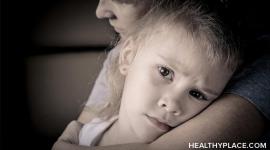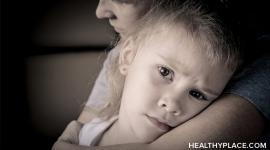Reactive Attachment Disorder (RAD) Symptoms

Symptoms of reactive attachment disorder (RAD) are a result of the extreme neglect that causes this trauma disorder. In reactive attachment disorder, infants and young children don’t form a bond with caregivers, a bond which is necessary for healthy social, emotional, and behavioral development. A telltale RAD symptom is the lack of turning to a caregiver for needs like comfort, support, and protection.
The symptoms of reactive attachment disorder are behaviors, thoughts, and emotions that are adapted to compensate for basic needs that are unmet. When an infant or young child can’t count on being nurtured, he/she learns that the world is unsafe, untrustworthy, and unpredictable. As a result, reactive attachment disorder symptoms are seen in all aspects of a child’s existence (Parenting a Child with Reactive Attachment Disorder).
Nature of Reactive Attachment Disorder (RAD) Symptoms
In general, symptoms of mental health disorders fall into two broad categories: internalizing and externalizing. Symptoms of reactive attachment disorder are internalizing; that is, they are expressed inward, into the person rather than outward toward the world.
The internalizing symptoms of RAD are depressive and withdrawn in nature. Because of the trauma of neglect and the sense that he/she is alone, unprotected from an unsafe world, the infant or young child protects him/herself by pulling away from others. He/she doesn’t seek comfort when distressed, and if a caregiver happens to offer comfort, he/she turns away unresponsively.
While, according to the American Psychiatric Association’s (2013) Diagnostic and Statistical Manual of Mental Disorders, Fifth edition (DSM-5), reactive attachment disorder can only be diagnosed between the development age of nine months and five years, symptoms are evident before and long after that time frame (Reactive Attachment Disorder in Adults). RAD symptoms can be observed in all areas of the child’s life. Specific behavioral, emotional, physical and cognitive symptoms indicate that a child has developed RAD.
Behavioral/Social Symptoms of Reactive Attachment Disorder (RAD)
Behavioral symptoms of RAD are easily visible to outsiders. They involve how the child behaves at home and with others; therefore, behavioral symptoms of RAD are closely tied with social aspects of life. In children with RAD, these can include:
- Problems with feeding/eating
- Resistance to being held
- Lack of eye contact
- Failure to smile in response to others
- Disengagement and withdrawal; minimal involvement in games or other social play
- General lethargy/apathy
- Difficulty making friends
- Turning away from affection
- Self-soothing actions like rocking, rubbing arms, etc.
Emotional Symptoms of Reactive Attachment Disorder (RAD)
Emotional RAD symptoms are subjective experiences within the person with RAD, but because emotions and behaviors are interrelated, emotional RAD symptoms do show themselves in the above behaviors. Also, teens or older children often verbalize their feelings in therapy, and young children show them through play. The emotional symptoms of reactive attachment disorder involve:
- Feelings of emptiness
- Inability to feel trust
- Lack of a sense of belonging
- Feeling unwanted
- Feeling calmer alone than with others
- Chronic anxiety
- Chronic sadness/depression
- A heightened sense of fear
- Limited positive emotions
Physical Symptoms of Reactive Attachment Disorder (RAD)
While these physical signs alone don’t indicate RAD, they typically are present in infants, children, and teens with RAD:
- Failure to smile
- Failure to gain weight (a result of the neglect that causes RAD)
- Appearing joyless, expressionless
Cognitive Symptoms of Reactive Attachment Disorder (RAD)
Reactive attachment disorder affects thought processing. Often, children with RAD display
- developmental delays (reaching milestones later than age mates)
- language delays
- delayed responses to stimuli/slow reaction time
When the trauma of severe neglect leads to RAD, the symptoms are all-encompassing, impacting the whole person. Symptoms of reactive attachment disorder affect behaviors, emotions, and thought processing, and they’re often physically noticeable. These RAD symptoms have long-term effects on children, teens, and even adults.
APA Reference
Peterson, T.
(2021, December 17). Reactive Attachment Disorder (RAD) Symptoms, HealthyPlace. Retrieved
on 2025, December 31 from https://www.healthyplace.com/ptsd-and-stress-disorders/reactive-attachment-disorder/reactive-attachment-disorder-rad-symptoms


